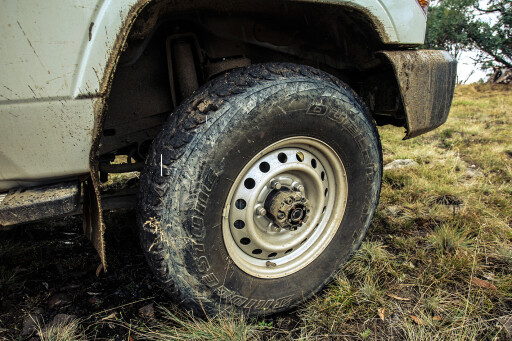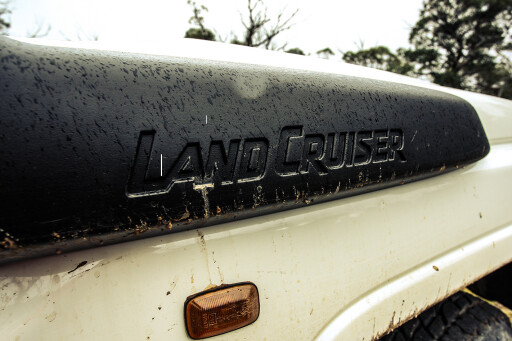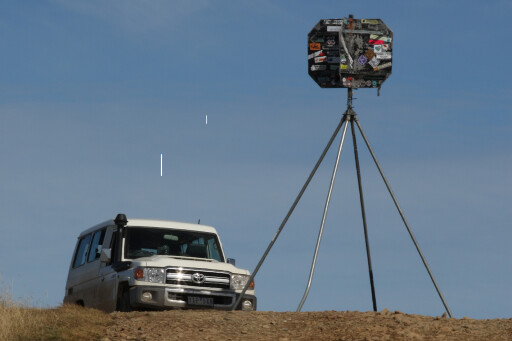
A KEY aspect to the popularity of Toyota’s 70 Series Land Cruiser range is the versatility of the vehicles. Over the past 10 years the popular single-cab 79 Series workhorse has expanded to include the double-cab version, and then there’s the VDJ76 and 78 Series wagons.
The Troop Carrier has been part of the 70 Series range since 1985 when the 45 became the 75 Troopy, and during its time it has been available in two-, three-, five-, six- and 11-seat models, but always as a two-door, high-roof wagon. Today’s VJD78 only comes in two variants: the two-seat Workmate base model and the five-seat GXL, as tested here. The Workmate has a list price of $64,890, while the GXL starts at $67,990.
 Updates to the 70 Series range at the end of 2016 brought improved safety and emissions features to the Troopy, including electronic traction and stability control, seatbelt pre-tensioners, electronic brakeforce distribution, and a diesel particulate filter and revised injectors to meet the latest emissions regulations. The age-old split steel rims and tall tyres that have been a part of base-model 70s since Moses drove one were replaced with single-piece 16x6-inch steelies and tall, skinny 225/95 tubeless tyres.
Updates to the 70 Series range at the end of 2016 brought improved safety and emissions features to the Troopy, including electronic traction and stability control, seatbelt pre-tensioners, electronic brakeforce distribution, and a diesel particulate filter and revised injectors to meet the latest emissions regulations. The age-old split steel rims and tall tyres that have been a part of base-model 70s since Moses drove one were replaced with single-piece 16x6-inch steelies and tall, skinny 225/95 tubeless tyres.
When we picked up this Troopy from Toyota’s office we thought we must have been getting a Workmate because of its wheels of steel, but we were surprised when we climbed inside to find carpet, power windows and front and rear differential locks. A check of the back door showed the GXL badge, and a look over the spec sheet told us GXL Troopies don’t get the alloy wheels and bigger 265 tyres found on other upper-spec models in the LC70 range.
INSIDE STORY
OUR test came at a time when an LC79 was in our long-term shed, so the inside of the Troopy presented a familiar place to be. There’s less support as the Troopy doesn’t get the updated seats of the ute, but the dash and controls are all pretty much the same. A pair of fuel gauges in the binnacle led us to find the sub-tank switch, as the 78 retains the two 90-litre diesel tanks from past models – unlike the 76 and 79 models that now come with a single 130-litre tank. The Troopy misses out on the extra airbags of the VDJ79 single cab and, as such, forgoes a five-star safety rating.
 In the suburbs the softer suspension and higher centre of gravity immediately distinguish the big wagon from the tray-back. It pitches and leans more through bends, but if you’re looking for on-road handling a Troop Carrier is the wrong vehicle for you. You do, however, need to be mindful of the high mass when negotiating side slopes and steep tracks when off-road. The performance of the 4500cc V8 engine and five-speed gearbox are the same from 70 to 70.
In the suburbs the softer suspension and higher centre of gravity immediately distinguish the big wagon from the tray-back. It pitches and leans more through bends, but if you’re looking for on-road handling a Troop Carrier is the wrong vehicle for you. You do, however, need to be mindful of the high mass when negotiating side slopes and steep tracks when off-road. The performance of the 4500cc V8 engine and five-speed gearbox are the same from 70 to 70.
The Troopy tours nicely out on the open road, with the taller fifth gear and addition of cruise control making it a more comfortable place to spend hours behind the wheel. The longer top gear drops engine revs by around 600rpm at 100km/h and, while a sixth gear would still be better, this is an adequate fix.
 With its cavernous cargo area and healthy payload you can see why the Troopy is the choice of vehicle for so many global travellers and those doing a lap of the map. The Troopy has a handy 975kg payload, as opposed to the single-cab ute’s 1225kg. Even with the rear seat in place, the space is still as big as most ‘regular’ 4x4 wagons when the seats are folded. Sans rear seat and the space is enormous, and adventurous Troopy owners can customise this area with all sorts of cargo, camping and sleeping arrangements. We were loading up for a week in the Vic High Country and were disappointed to find no tie-down points in the cargo area – we assume Toyota expects owners to customise with their own points (likewise 12-volt power outlets).
With its cavernous cargo area and healthy payload you can see why the Troopy is the choice of vehicle for so many global travellers and those doing a lap of the map. The Troopy has a handy 975kg payload, as opposed to the single-cab ute’s 1225kg. Even with the rear seat in place, the space is still as big as most ‘regular’ 4x4 wagons when the seats are folded. Sans rear seat and the space is enormous, and adventurous Troopy owners can customise this area with all sorts of cargo, camping and sleeping arrangements. We were loading up for a week in the Vic High Country and were disappointed to find no tie-down points in the cargo area – we assume Toyota expects owners to customise with their own points (likewise 12-volt power outlets).
 The back seat in the Troopy is a very basic affair, with thin cushions, upright positions and no adjustability, and access to it is a real pain due to the lack of rear doors. The inwards-facing seats that were fitted to 11-seat Troopies have been axed due to safety. At its best, a Troopy is a two-up tourer with a cargo barrier behind the front seats to maximise use of the cargo hold.
The back seat in the Troopy is a very basic affair, with thin cushions, upright positions and no adjustability, and access to it is a real pain due to the lack of rear doors. The inwards-facing seats that were fitted to 11-seat Troopies have been axed due to safety. At its best, a Troopy is a two-up tourer with a cargo barrier behind the front seats to maximise use of the cargo hold.
OFF-ROAD
THE 79 lurches and rolls around town, but it makes more sense when you get to low-speed, off-road driving. The upright seating and large glasshouse provides great visibility around the car; although the glare off the back of the taller bonnet hump (of this white car in particular) was annoying to the driver, something we haven’t found when driving the dark-red ute.
 In low range the Cruiser V8 growls its way up anything, and the calibration of the new electronic traction control surprised with its effectiveness on wet tracks, even when the wheels were lifted. Having ETC means you resort to the diff locks less than you would have in the past, but it was still nice to have them there just in case.
In low range the Cruiser V8 growls its way up anything, and the calibration of the new electronic traction control surprised with its effectiveness on wet tracks, even when the wheels were lifted. Having ETC means you resort to the diff locks less than you would have in the past, but it was still nice to have them there just in case.
The skinny tyres offered no reasons for complaint during five days of off-road touring. With pressures dropped, the odd-sized 225/95-16s crawled without wanting for traction in the wet and dry. We followed vehicles with bigger tyres and raised suspension up tracks they scrambled on. That said, if we were building a Troopy for outback touring – as so many people do – we’d be looking for a more common tyre size, such as 265/75-16s on wider wheels, to ensure availability in remote areas.
 While plenty of folk are quick the criticise the LC70 for its modest power output in relation to the size of the engine, the variation in its front-to-rear wheel track, and its purchase price, none of those factors posed a problem for us. There are a couple of causes for complaint, though: the aforementioned lack of tie downs and power sockets in the rear, and the comfort of the seats. My back was stuffed following a week of off-road driving in the 78, something that hasn’t happened at all in the 79 – I put it down to the older seats.
While plenty of folk are quick the criticise the LC70 for its modest power output in relation to the size of the engine, the variation in its front-to-rear wheel track, and its purchase price, none of those factors posed a problem for us. There are a couple of causes for complaint, though: the aforementioned lack of tie downs and power sockets in the rear, and the comfort of the seats. My back was stuffed following a week of off-road driving in the 78, something that hasn’t happened at all in the 79 – I put it down to the older seats.
You could turf out the back seat, kit-out the cargo area, and update the wheels, tyres and suspension, and then set off around the country with little or no other major modifications. We’re not sure if the Troopy is the best tool in the toolbox, or the ultimate toolbox? There really isn’t another new 4x4 vehicle like it.
SPECS
Engine: 1VD-FTV single turbo, diesel V8. Common-rail EFI
Capacity: 4461cc
Max Power: 151kW @ 3400rpm
Max Torque: 430Nm @ 1200-3200rpm
Gearbox: 5-speed manual.
Crawl ratio: 37.29:1
4x4 System: Part-time 4x4 with dual range transfer. F&R diff locks
Construction: two-door wagon on a ladder chassis
Front suspension: Live axle coil sprung
Rear suspension: Leaf sprung live axle
Wheel and tyre spec: Steel wheels with 225/95 16C tyres
Kerb Weight: 2325kg
GVM: 3300kg
Payload: 975kg
Towing capacity: 750/3500kg
Seating capacity: Five
Fuel tank capacity: 180 litres
ADR fuel consumption*: 10.7L/100km
On-test fuel consumption: 16.9L/100km (off road)
*Australian Design Rule ‘Combined-Cycle’ claim



COMMENTS